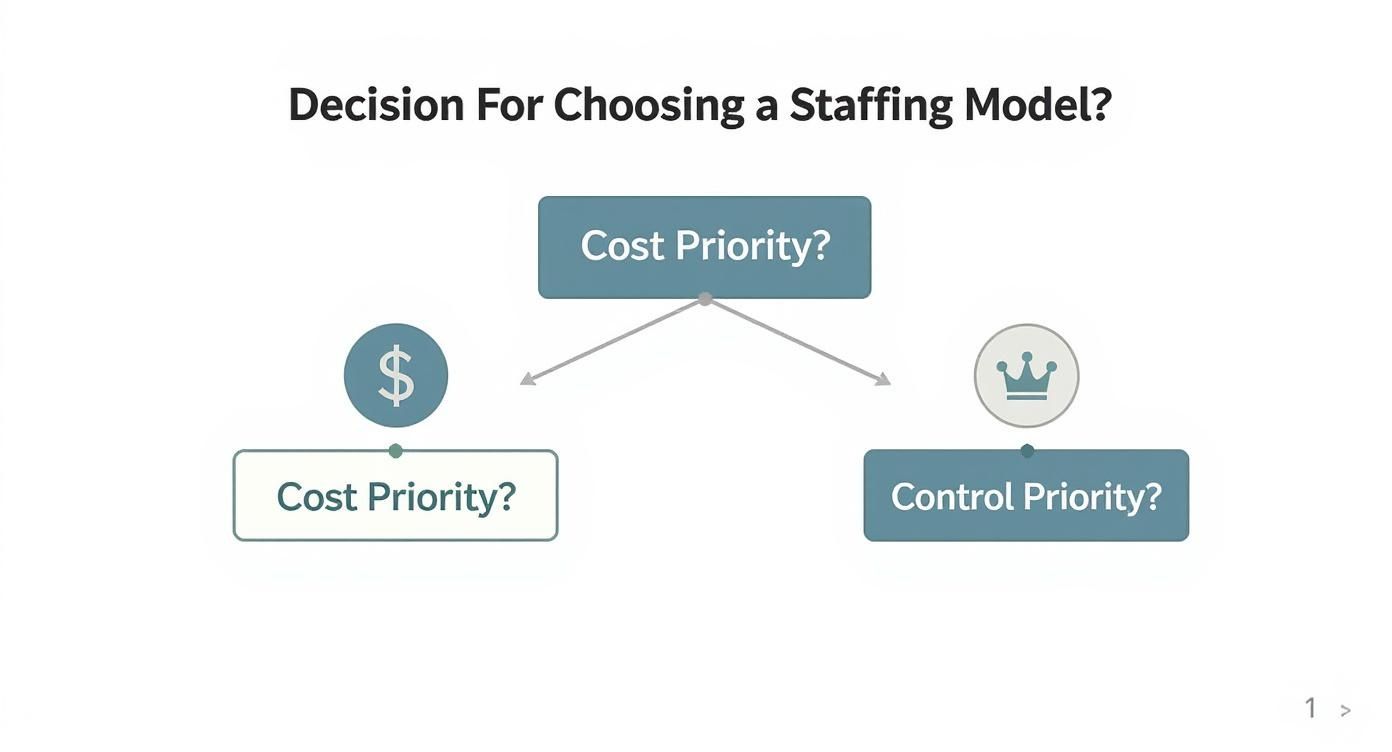Your call center staffing model is really the blueprint for your entire customer support operation. It's the core strategy that dictates who answers your customer calls and where they do it from. Getting this right is a delicate balancing act between keeping costs down, maintaining control over your brand's voice, and making sure your customers are happy.
Think of your staffing model as the operational DNA for your customer service. It’s the foundational choice that shapes everything that comes after—from your annual budget and the consistency of your brand messaging to how quickly you can adapt to a sudden rush of calls during your busy season.
Before you can even begin to sketch out a model, you have to get a handle on the persistent customer preference for phone support. This isn't just a minor detail; it's a critical piece of data that directly tells you how many people you'll need on the phones. The right model can feel like a superpower, boosting your team's performance while keeping your budget in line. The wrong one? It's a fast track to frustrated customers, burned-out agents, and a lot of wasted money.

Every staffing model, no matter how complex it seems, boils down to just a few fundamental decisions. These choices are the pillars that support your entire customer service structure, influencing its cost, flexibility, and overall effectiveness. Getting clear on these is your first step.
The key strategic pillars you'll need to decide on are:
Choosing a staffing model is a lot like picking an engine for a car. You have to match its power, efficiency, and cost to the kind of driving you'll be doing—whether that’s cruising down the predictable highway of steady call volume or needing to accelerate instantly to handle unexpected traffic jams.
This guide will walk you through the four main call center staffing models you'll encounter: in-house, outsourced, hybrid, and the increasingly popular AI-augmented model. We'll dig into the real-world pros and cons of each, giving you a clear roadmap to help you pick the approach that truly fits your business.
The in-house call center is the classic, most traditional approach. You build your customer service team from the ground up, hiring, training, and managing every single agent directly. They’re your employees, working in your office, fully immersed in your company.
Think of it like having an in-house chef versus ordering takeout. You have total control over the ingredients, the recipe, and the final presentation. This model is all about creating a team that lives and breathes your brand, making them true experts on your products and culture.

When your team is in-house, brand consistency is baked into the cake. Your agents absorb the company’s mission and values just by being there, which means every customer conversation naturally hits the right notes.
This close proximity also creates an incredible feedback loop. Agents can walk down the hall to talk to the product team about a recurring issue or share customer insights with marketing. It’s a direct line from the customer’s mouth to the rest of your business.
The main upsides really boil down to:
When you build your team internally, you’re not just filling seats. You’re cultivating a dedicated group of specialists who get the tiny details and nuances of your business in a way no outside partner ever could.
Of course, that level of control doesn't come for free. The in-house model is easily the most expensive and operationally heavy option on the table. You’re on the hook for everything: salaries, benefits, office space, computers, software—the whole nine yards.
The challenges are pretty straightforward:
Ultimately, going in-house is a strategic bet on quality and brand integrity. It’s the perfect fit for companies with predictable call volumes, complex products, and a brand built on a premium, white-glove customer experience. For them, the benefits of a deeply integrated team make the high operational costs a worthwhile investment.
Let’s be honest: building and running an entire in-house call center is a massive undertaking that’s just not practical for many businesses. This is where outsourcing comes in as a powerful alternative. The idea is simple: you partner with a specialized, third-party company to handle your customer calls and interactions.
Outsourcing is one of the most popular call center staffing models for a reason. It's like flipping a switch to instantly scale your operations. You get immediate access to a trained, fully-equipped team without sinking a fortune into hiring, training, and infrastructure.
Suddenly, things that seemed impossible are now on the table. Need seamless 24/7 support? No problem. Want to tap into a global talent pool? Done. It’s no surprise the global call center outsourcing market is booming, growing to an estimated $339.4 billion in 2023 and projected to hit $496 billion by 2027. This incredible growth shows just how many companies are turning to this model for speed and efficiency. You can discover more about these trends and how they’re shaping the industry.
But this flexibility doesn’t come without a catch. You're handing over a core piece of your customer experience to an outside partner. That means giving up some direct control over your brand's voice and how quality is managed.
Outsourcing isn't a one-size-fits-all deal. Where your partner is located completely changes the game in terms of cost, culture, and how you manage the relationship. There are three main flavors to consider:
Choosing an outsourcing partner is like hiring a general contractor to build your house. You’re trusting them to bring your blueprint to life. A great partner delivers exactly what you envisioned, but a bad one can create structural problems that are a nightmare to fix down the road.
Deciding to outsource means carefully weighing the powerful benefits against the potential downsides. On one hand, the advantages can supercharge your growth. You get instant access to infrastructure, technology, and a trained workforce, letting you scale up or down at lightning speed to match customer demand.
On the other hand, the risks all circle back to control and brand identity. Communication can be tricky, and making sure every outsourced agent truly represents your company's values requires a rock-solid partnership and crystal-clear guidelines. You have to decide if the agility and cost savings are worth creating some distance between you and your customer-facing team. This is why picking the right partner is, without a doubt, the most important decision you'll make in this process.
The old, rigid lines between call center staffing models are starting to fade, making way for smarter, more adaptable strategies. The hybrid model is a perfect example of this shift, giving you the best of both worlds: the tight quality control of an in-house team and the on-demand scalability of outsourcing.
Think of it like this: you keep a core team of your most experienced, in-house agents to handle the really tricky or sensitive customer issues. Meanwhile, you let an outsourced partner manage the routine stuff, cover after-hours calls, or handle those crazy seasonal spikes in volume. This smart division of labor builds a resilient, cost-effective operation without ever compromising on quality where it counts.

Going hand-in-hand with the hybrid approach is the explosion of fully remote teams. Thanks to modern cloud technology, this model frees your agents from a physical office, letting them work from anywhere with a decent internet connection. This isn't just a fleeting trend; it's a fundamental change in how the best support teams are being built and run.
The biggest win here is the immediate access to a much, much larger talent pool. You’re no longer stuck hiring the best person you can find within a 30-mile radius of your office. Suddenly, you can recruit top-tier talent from anywhere in the country—or even the world.
This opens up a world of possibilities for the quality and diversity of your team. You can find agents with niche language skills, deep technical know-how, or specific industry experience that would be nearly impossible to source from one location.
When you embrace remote work, you stop competing for a limited local pool of talent and start fishing in a global ocean. It's how you build a more skilled, dedicated, and cost-effective workforce.
Beyond just finding great people, the remote model delivers real, tangible results. It turns out that agents who have the flexibility to work from home report higher job satisfaction and a better work-life balance. And happy agents provide better customer service. It’s a direct line.
The data tells a clear story. A well-known Stanford study found that remote call center agents actually improved their performance by 13%. On top of that, virtual contact centers consistently see much lower turnover rates than their traditional, office-based counterparts. To get a better sense of the numbers, you can learn more about call center performance statistics.
Ultimately, building a motivated, stable team that performs at a high level is one of the most powerful arguments for adopting a more flexible, remote-first staffing strategy.
Let's get one thing straight: Artificial Intelligence isn't here to replace your call center staff. Instead, think of it as giving every single agent a super-powered assistant. AI is reshaping staffing models by creating an augmented workforce where technology handles the grunt work, freeing up your human team to do what they do best.
Imagine an AI co-pilot that fields the easy questions, routes calls to the perfect specialist on the first try, and handles all the data entry while the conversation is still happening. This is a game-changer for tackling the repetitive tasks that grind agents down and lead to burnout. Your skilled people can now pour their energy into the complex, high-stakes conversations that require a human touch.
Modern AI tools are like having a coach whispering in your agent's ear during a live call. The system listens to the conversation and can pop up real-time suggestions, pull relevant articles from a knowledge base, or provide critical customer history right on the agent's screen. This is huge for getting new hires up to speed quickly and ensuring even your seasoned pros have exactly what they need, right when they need it.
This kind of on-the-fly support has a direct impact on the metrics that matter:
By 2025, it's expected that nearly all contact centers—around 98%—will be using AI for routing, coaching, and analytics. But this isn't just about efficiency. It’s a critical strategy for tackling the industry’s massive agent turnover problem, which can hit 75% annually. With recruitment and training costs ranging from $10,000 to $15,000 per new hire, AI's ability to reduce agent stress becomes a powerful retention tool. You can find more data on current call center trends and challenges.
Beyond helping with individual calls, AI gives you a bird's-eye view of your entire operation. It can sift through thousands of conversations in minutes to spot recurring customer complaints, detect subtle shifts in sentiment, and even flag potential problems before they blow up.
Integrating AI into your team is like giving every agent a personal data analyst and coach. It elevates their performance from simply answering calls to actively solving problems and strengthening customer relationships.
This means you can stop being reactive. You can start proactively improving your products, services, and processes based on hard data. An AI-augmented model turns your call center from a necessary expense into a strategic intelligence hub that drives both efficiency and customer loyalty. This powerful shift is a cornerstone of modern call center staffing models.
So, you’ve seen the different ways to staff a call center. But how do you translate those models into a decision that actually works for your business? The truth is, there’s no magic bullet. The "best" option is simply the one that clicks with your specific goals, budget, and brand identity.
Making the right choice really boils down to asking a few honest questions.
First, define what a "win" looks like for your support team. Is your number one priority to slash operational costs as low as they can go? Or is it absolutely non-negotiable to maintain tight control over every single customer conversation? Think about your call volume, too. Is it a steady, predictable flow, or does it swing wildly with the seasons?
The answers will start pointing you in the right direction. Imagine a luxury car brand that sells a highly complex vehicle. They'd almost certainly lean toward an in-house team. Why? Because they need agents with deep product knowledge who can deliver a premium, consistent brand voice every time.
Now, picture a fast-growing e-commerce startup gearing up for the holiday chaos. For them, the ability to scale up instantly with an outsourced model is far more valuable than keeping everyone under one roof.
This decision-tree infographic breaks down the main paths you might take, depending on whether you're focused more on cost or control.

As you can see, prioritizing cost savings tends to push businesses toward outsourcing. On the flip side, a heavy focus on control and quality makes in-house or hybrid models look a lot more appealing.
When you’re weighing the pros and cons, it helps to look at the bigger picture. The long-standing debate over in-house versus outsourced teams in departments like marketing offers some great lessons for call center staffing. The core principles are the same: you're always balancing control, expertise, scalability, and cost.
Your staffing model is a direct reflection of your company's values. A model that puts cost savings above all else will create a very different customer experience than one built around brand expertise and total control.
Ultimately, this isn't just an operational choice; it's a strategic one. Your decision has to line up not just with your budget, but with the kind of relationship you want to build with your customers. By carefully thinking through these factors, you can confidently pick the staffing model that will support your business today—and wherever it grows tomorrow.
When you're digging into the different ways to staff a call center, a few questions always seem to pop up. Let's tackle them head-on, so you can move forward feeling confident about the path you choose for your business.
If we're talking purely about the lowest direct labor cost, the outsourced model—especially offshore outsourcing—is usually the winner. But the cheapest option isn't always the most cost-effective.
True value comes from balancing that price tag with the quality of service you get. An AI-augmented model can also be incredibly budget-friendly, not by cutting corners, but by making a smaller, highly-skilled human team massively more efficient.
Absolutely. In fact, you should. Thinking of your staffing model as a flexible strategy is one of the smartest things you can do.
Many businesses start out with an in-house team to really nail down their brand voice and processes. As they scale, they might shift to a hybrid model, bringing on an outsourced partner to handle after-hours calls or cover those crazy seasonal spikes. The trick is to build your internal systems with flexible technology from the get-go.
Your first choice isn't set in stone. Treat your staffing model like a living part of your business—one that should grow and adapt to meet new challenges and opportunities.
Your industry plays a huge role in this decision. What works for a retail giant would be a terrible fit for a healthcare provider.
Here’s how it often breaks down:
Ready to augment your team with powerful AI? My AI Front Desk provides an AI receptionist that handles calls 24/7, converting leads and boosting revenue so your human staff can focus on high-value tasks. Explore how our AI solutions can optimize your staffing strategy today.
Start your free trial for My AI Front Desk today, it takes minutes to setup!








